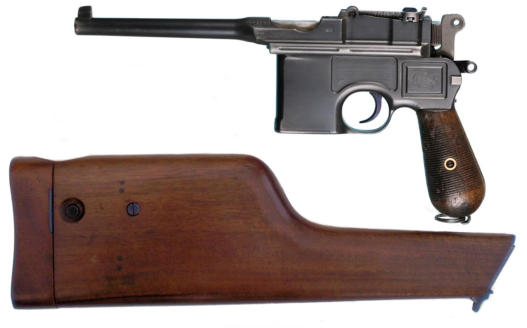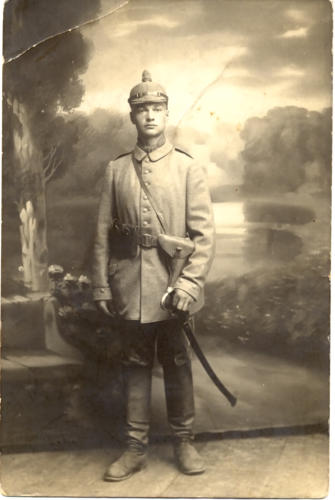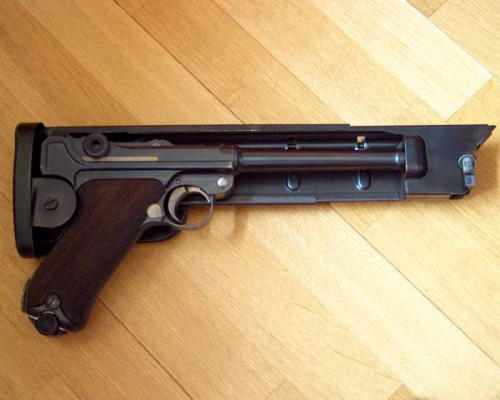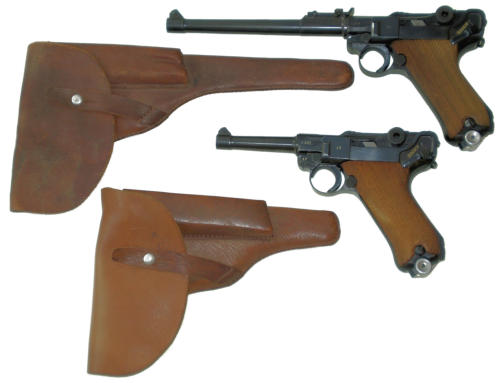Introductory article
At the beginning of the 1900’s there was much interest in the use of the first semi-automatic pistol both as pistol and carbine. This demand was felt both in commercial and in military domains. The Borchardt , the Mauser C96 , and the Luger Carbine are some examples of this interest. The Artillery Luger represents an historical milestone in the development and use of the pistol-carbine semiautomatic in the military domain. The military use of the Luger Artillery Model ended after the Great War, even though a limited production of automatic LP08 pistols was made during the Second World War. In the commercial domain the success of the Artillery Luger Model continued, especially in the United States, up to the second half of the 1930’s. Several catalogs of the epoch are reporting to us this interest ( Stoeger , Frantzius , Pacific Arms ). After the Second World War, the Mauser firm produced the Luger Artillery Model, under French control, from 1945 up through 1947. Most recently Mauser produced this model in a limited commemorative series during the 1985-86 time-frame. This article will briefly summarize the history of this model. Those who are interested in a thorough analysis of Artillery Luger history can refer to the book “La Luger Artiglieria – The Luger Artillery” , the first book completely dedicated to this model. This book contains more than 190 photos and describes various models and accessories. Military Requirements In 1907, the German Artillery requested the development of a pistol-carbine. Comparative tests were done between several pistols of the day, the Borchardt, the Mauser C96, and the Frommer, but these pistols were not chosen for adoption. In 1908 the German Army adopted the Pistole 08 (P08). The Kriegsministerium decided at that time to re-consider the artillery requirements. Captain Adolf Fischer was assigned to head a team, that in collaboration with DWM / Deutsche Waffen – Und Munitionsfabriken, was tasked develop such a variation. It is possible to trace several technical solutions back to the previous models. The first stocked Lugers with 7 inch barrels were produced for the South American market around 1900. Many of these Lugers have the GL stamp which indicates that Mr. Georg Luger, inventor of the pistol, was directly involved in the supervision of their manufacture. The serial number of these weapons falls in the interval 10.000-10.050. Experiences with these pistols were refined and incorporated into the Luger model Carbine. The Imperial German Navy also adopted a pistol-carbine, the Selbstladepistolen 1904 (P04) . Captain Fisher was inspired by these preceding models to fulfill the Artillery requirements. The result was a Luger with an 8 inch barrel, an 8-position tangent rear sight (calibrated to 800 meters) and a shoulder stock with holster. Kaiser William II approved the official use of the LP08 on June 3 rd 1913. LP08 Use The Imperial Artillery was the first military unit to use the new Luger but, due to this model’s extreme flexibility, other types of military units including the famous elite troops Sturmtruppen also employed it. The new aviation military units also used the Luger Artillery. Several tests were performed for evaluating the effectiveness of the pistol in aerial fights, and in the damage experienced on the airplane engines. But the Sturmtruppen, on the Western front, proved to be the most important use. The historical pictures are today a useful instrument to analyze and clarify the use of the LP08. World War I quickly turned into a stagnant trench war. A philosophy of "live and let live" silently and comprehensibly emerged among the soldiers on both sides. The soldiers clearly preferred to maintain their trench positions instead of inconclusive and costly blood-thirsty attacks. With the intent to break this "status quo", a new tactic of fighting was developed. The new tactic introduced the use of small groups of well-armed soldiers with limited objectives. For the first time, infiltrations into hostile lines were used. The Sturmtruppen were also armed with the LP08 with a new large capacity magazine. The Trommelmagazine provided a great volume of fire that was effective in the trench fighting. This magazine loaded up to 32 rounds of ammunition. It was carried in unusual holsters made of cloth (some Trommelmagazine holsters presented in my book are shown in leather, but there is no confirmation on their actual use in combat). The Trommelmagazine, together with the special loading tool and the ammunition, were stored and transported in a wooden box called a P-Kasten . The Model History This section will briefly describe the Luger Artillery models, from the Imperial types to the Commemorative models produced in 1985-86. We begin with the acceptance prototypes produced by the DWM for the Army qualification trials. DWM made about fifty pieces between 1912 and 1913. Charles Kenyon, Jr. wrote a very good article on these pre-production pistols. These pistols obviously don't have the standard military acceptance stamps. The followings aspects characterize them: 1. The date is not present on the chamber; 2. The rear sight numbers are engraved; indicative of the care applied to this pistol (this is also evidence that not all the production tools were available yet. DWM used the results of the trials as justification to invest in the production tools). 3. The diameter of the sight adjusting screw is larger than the later production. 4. The serial number was stamped on the front of the frame and doesn’t follow the military standard at all. 5. The inner rear frame re-enforcement is not present. It seems that the first Luger Artillery were equipped with a prototyping stock , similar to the one used with the Mauser C96. In fact, it is possible to put the LP08 inside this stock as for the C96. Recently some replicas of this holster/stock have been produced and the result is really interesting. This stock was not retained for the final configuration. Following Army acceptance, the production of the LP08 was assigned to DWM, and also to the Royal Arsenal of Erfurt. Erfurt produced the LP08 only in the year 1914, DWM production continued up to the end of the First World War. When WWI was over, the Treaty of Versailles placed the LP08 among the weapons that were prohibited for manufacture and issue. Many of them were unfortunately destroyed. Some were reworked by an arsenal and had the barrel shortened and many others were hidden away. The LP08 only remained in service with the Navy. With the intent to distinguish government-owned weapons from those that were contraband or clandestine, on August 7, 1920, an order was issued by the Reichstag, known as "law for disarmament of the people," that forced all persons to turn in all contraband war weapons obtained from the battlefields during the conflict and also during the revolutionary movements that followed the war. The directive "Inspektion der Infanterie Nr. 657.T 20 J2s (W.2)" introduced perhaps a most unique circumstance in history, in that the year “1920” was stamped on government-issued weapons as evidence of state ownership. This activity created the variation known as the Luger “double date” . These pistols are characterized by the double date over the chamber. Actually the state property mark of “1920” was stamped above the manufacture year chamber date. There are some LP08s known in this configuration. After WWI, the German economy was characterized by enormous inflation. The American market was the only national market to experience growth. In the United States during the 1920’s, several different importers commercialized the sale of Luger pistols. Among the principal vendors, we can identify Stoeger & Co. (of New York), and Pacific Arms Corporation (of San Francisco). In this period, Artillery Lugers with barrels as long as sixteen inches (twice as long as the basic model) appeared. For the first time the Artillery Luger appeared in caliber .30 (7.65mm) Luger. These weapons were often mounted with a 10-position rear sight. Stoeger is considered the most active importer and requested that DWM personalize the production of its Lugers. Starting in 1923 the Lugers imported by Stoeger have, on the right side, the inscription A.F. STOEGER Inc. / New York. On October 5th 1929, Stoeger was granted exclusive commercial trademark in the use of the name Luger. From this date all the Stoeger imported Lugers bore the stamp GENUINE LUGER - REGISTERED U.S. PATENT OFFICE along the frame rail below the upper receiver. Beginning in 1930, the production of the Luger pistols moves from DWM to Mauser located in Oberndorf; Mauser was part of the Loewe Group since December 1887 and DWM was set up in November 1896. Loewe was the parent company of DWM. just as DWM was the parent company of Mauser. In 1928, the control of the DWM Company was obtained by the Quandt Group. Mauser production through 1934 was based on the old DWM orders. The Stoeger Artillery Lugers were produced by Mauser maintaining the DWM stamp on the toggle. After 1934, Mauser distinguishes between military and commercial Luger production orders. In this period, two interesting variations of Artillery Luger are produced, the Persian and Siamese models. The Persian model is characterized by numerous Farsi language inscriptions. These models are considered very interesting and “exotic”. The Siamese model is the first LP08 created with the commercial Mauser Banner. Recently a new variation resurfaces; in fact, some Imperial Luger (P08, Navy and LP08) with Thai marks have been found. These pistols survived WWI and were sold as surplus to the Royal Thai Police somewhere between 1919 and 1937. They are characterized by particular Thai stamps . There are some examples of use of LP08 during WWII; for sure some LP08 where used in Italy during the Anzio’s battle. It seems that a telescopic stock has been associated to this pistol but there are no official documents tracing this point. Recently, it has been discoved that the above mentioned telescopic stock was manufactured in Japan by MTC as an accessory for their Luger pistol copies. At the end of the Second World War, the French Army occupied the Mauser factory in Oberndorf and took over the production of the P08. During this period of French control, a small number of LP08 models were also produced. The P08 was used by the French Police (Gendarmerie), and also by the French Army, especially in Indochina. Up to know five variations of P08 have been reported. It is possible to find the LP08 in the second and third variations. The second variation is characterized by French “*” (star) proof mark; the third one by the Commercial nitro German eagle/n proof mark. The total amount of Luger production under French control should be not greater than 3500 specimens. Up to know only ten Luger Artillery have been reported by collectors. Therefore the 1946-1947 Mauser LP08 made under French control is one of the most rare and collectible variations. The P08 was mainly used in the Indochina and Alger wars. In 1950, 5000 P08 manual have been published mainly for the army gunsmith involved in the Indochina war. These manuals are today really rare. The French Army used also the P38 pistol. Also for this model a similar user manual has been published in the same year. In the 1948, the dismantling process started and in 1953 the Mauser firm is completely liquidated. In 1969, Mauser was awarded a contract by Interarms in the United States and production of the P08 was commercially resumed. Mauser initially bought the entire production package of the 1929 Swiss model. In particular, it has been acquired all the inspection gauges necessary to evaluate the dimension of each single part of the gun. Not all the gauges where adequate to evaluate the new produced pistols therefore Mauser made specific gauges . Recently the gauges acquired by Mauser from the Swiss and made also by Mauser have been found in Oberndorf . The new Mauser was based on three pistol types: · The model known as 29/70 , similar to the 06/29 Swiss model; · The model 06/73 , analogous to the P06 model; · And the Commemorative models. The contract with the Interarms called for 100,000 Parabellum Pistols to be produced in 10 years. It is interesting to highlight that Mauser in the 1970’s was only able to produce 1000 guns per month against the 500-600 per day that were produced in 1939. In 1986, the production of the Commemorative models concluded with the production of the LP08. This last Artillery Luger was manufactured both in 7.65 mm, and 9 mm Parabellum. In the advertising of the period, it is written that the last Artillery models produced by the Mauser were inspired by the Stoeger, Persian, and Siamese models of the 1930’s. It is important to note that the blueprints and production tools for both pistols had been saved from destruction by August Weiss in 1947. The LP08 in caliber 7.65 mm Parabellum , due to the rarity of this calibre, is highly sought after by collectors. These guns were furnished in a particularly luxurious case that contained the pistol, the stock, the cleaning rod, the screwdriver and the sight adjustment tool. An extensive research has been performed by the author about the post WWII Parabellum. The result of this study has been summarized in a new book: “The Parabellum is back! 1945 - 2000”. Additional information can be find in the web site “ The Parabellum is back ”.
Artillery Luger pistol and Mauser Parabellum
Artillery Luger

© Mauro Baudino 2023 - all rights reserved














































